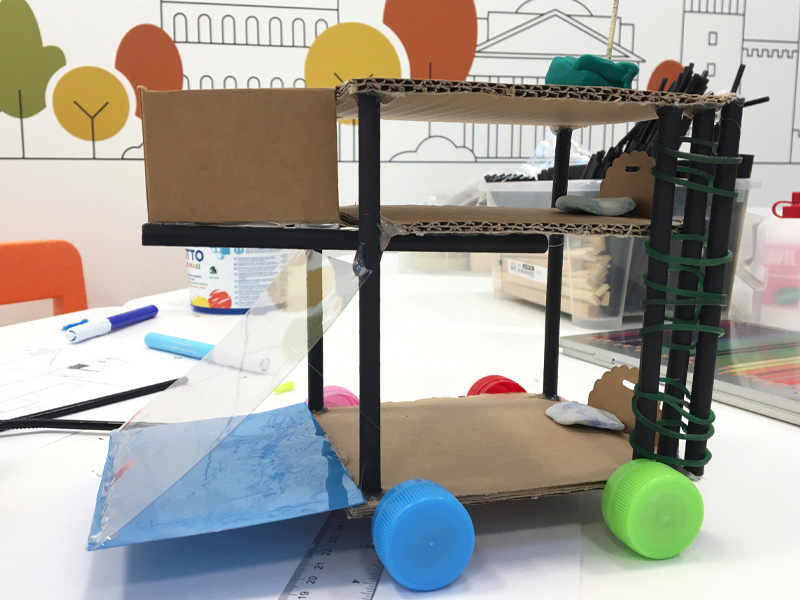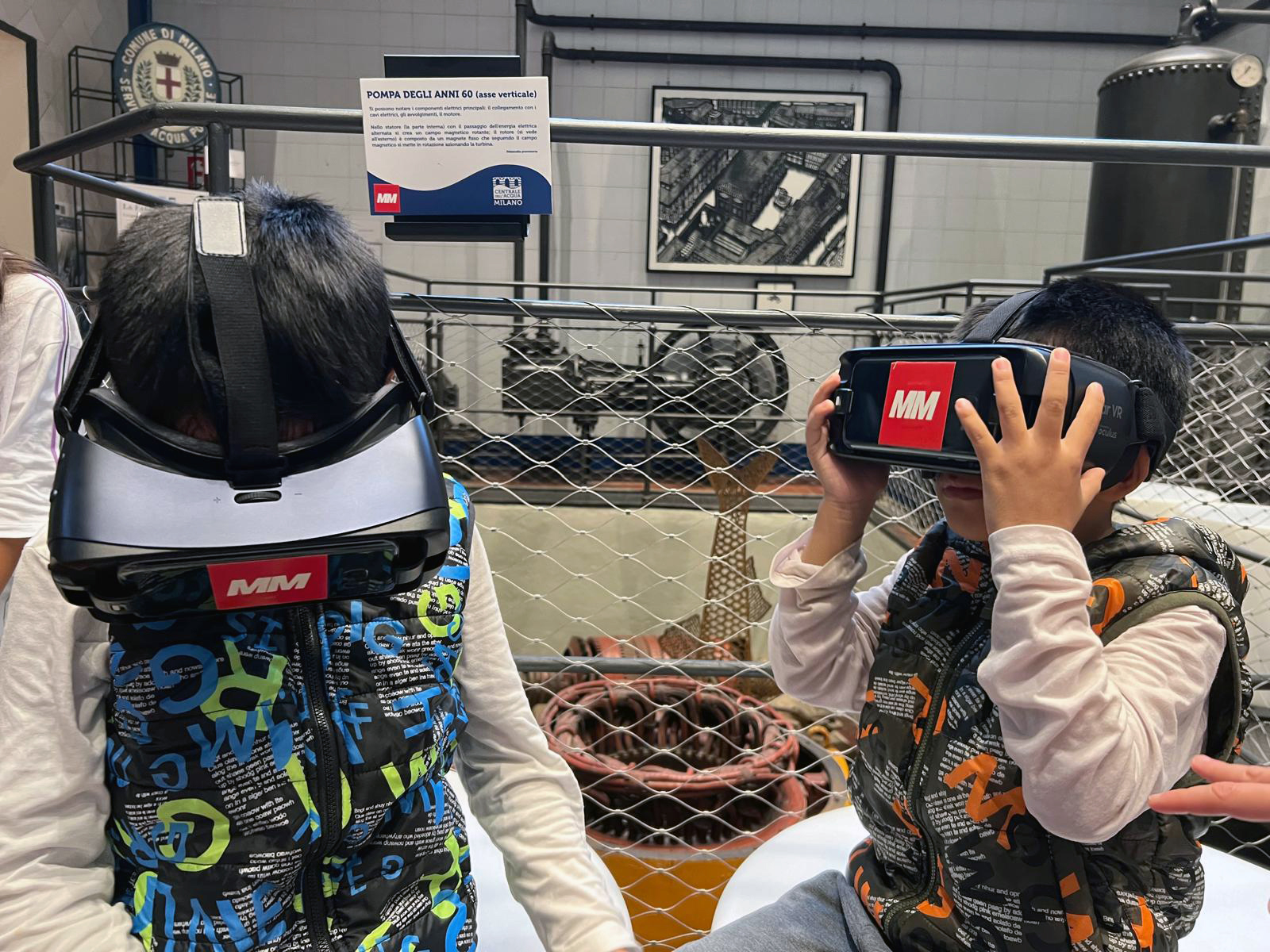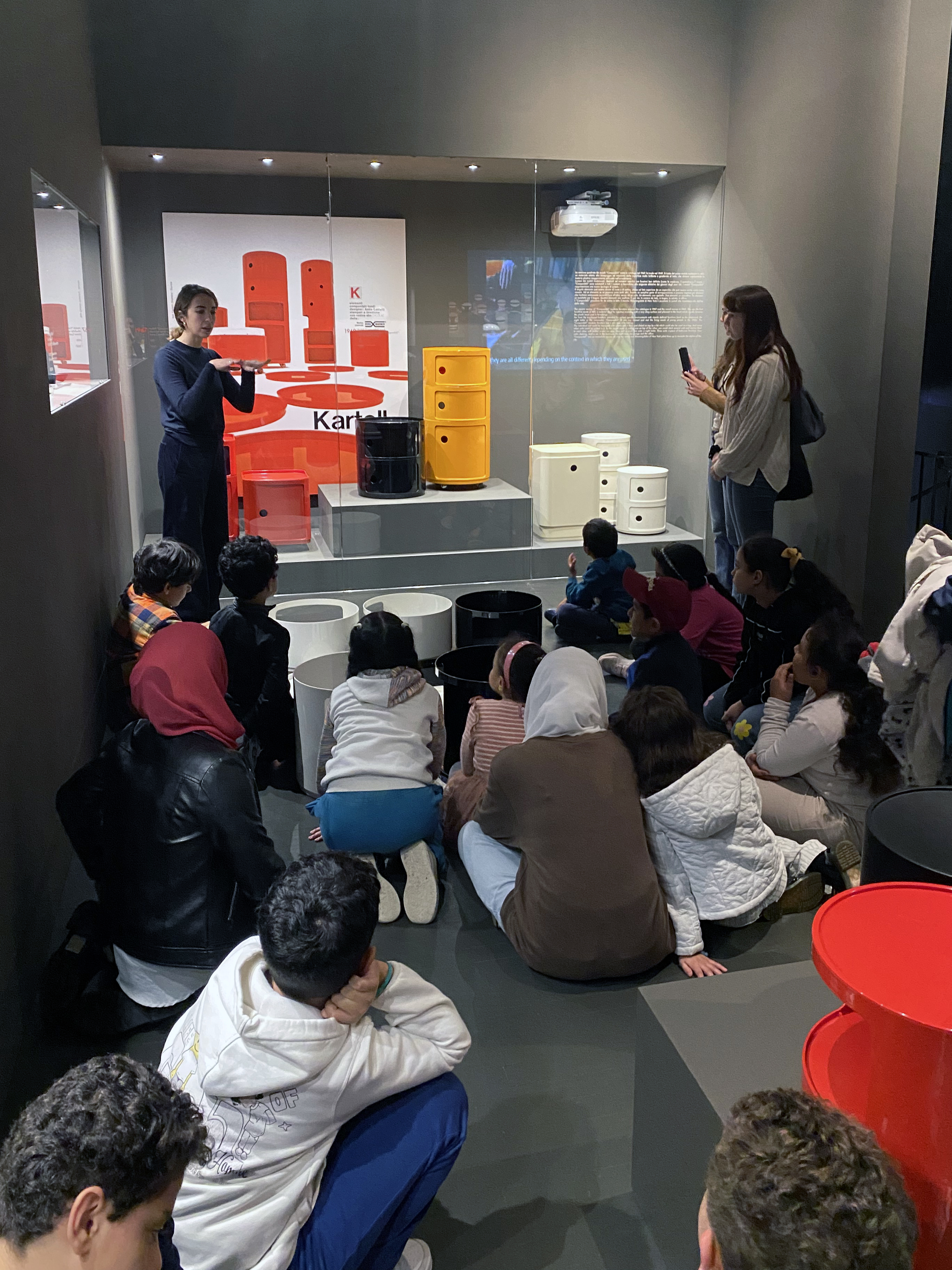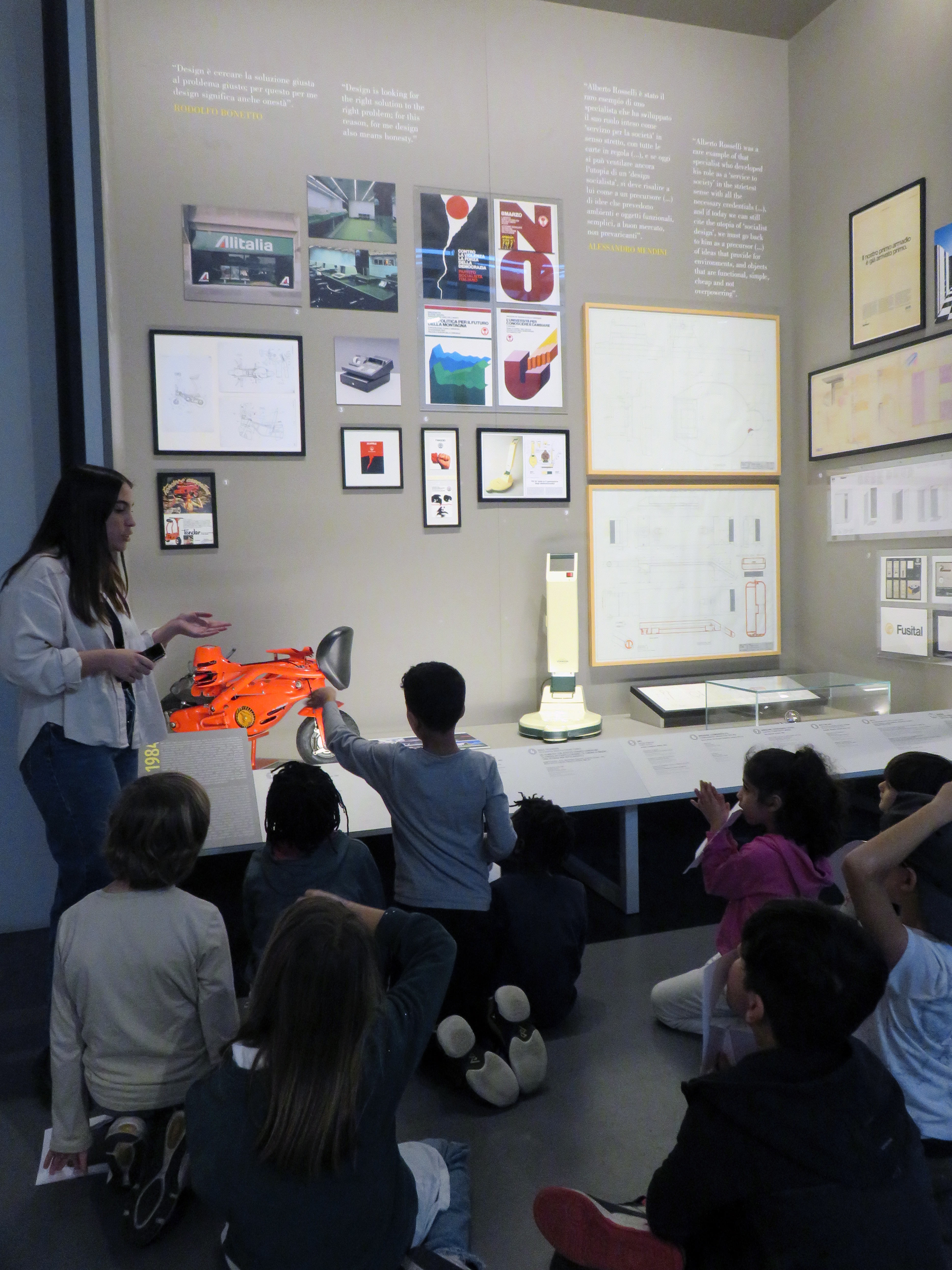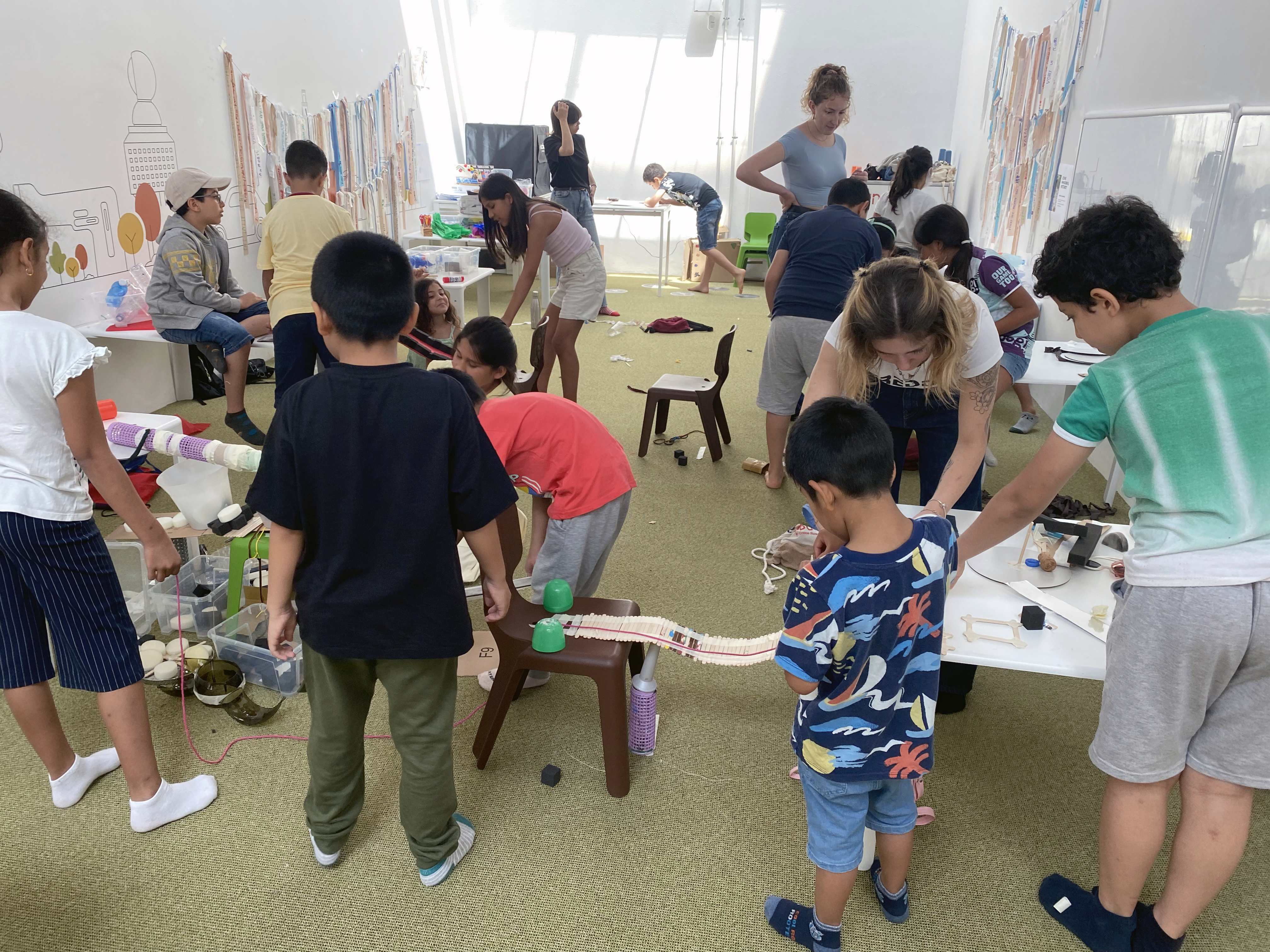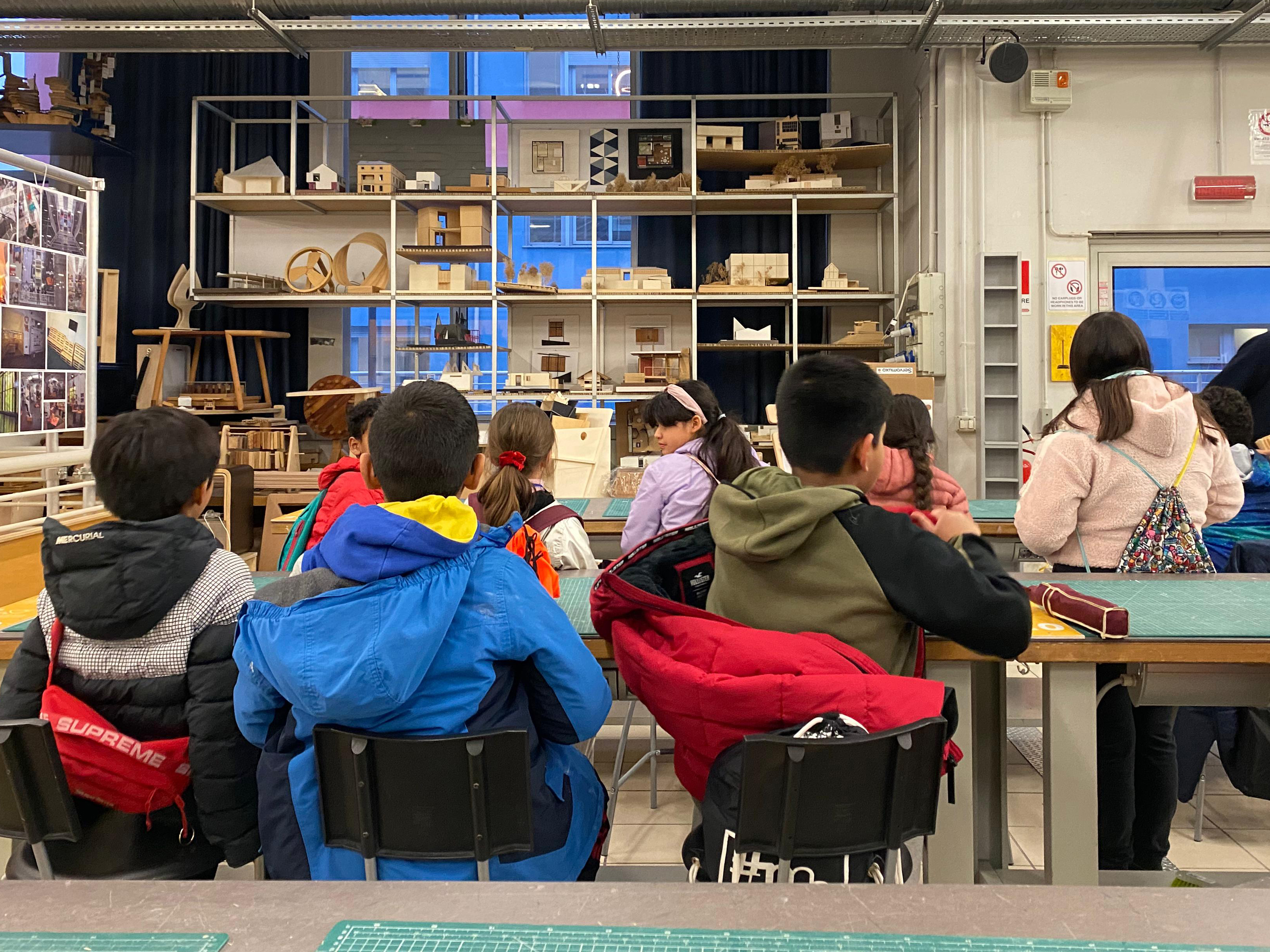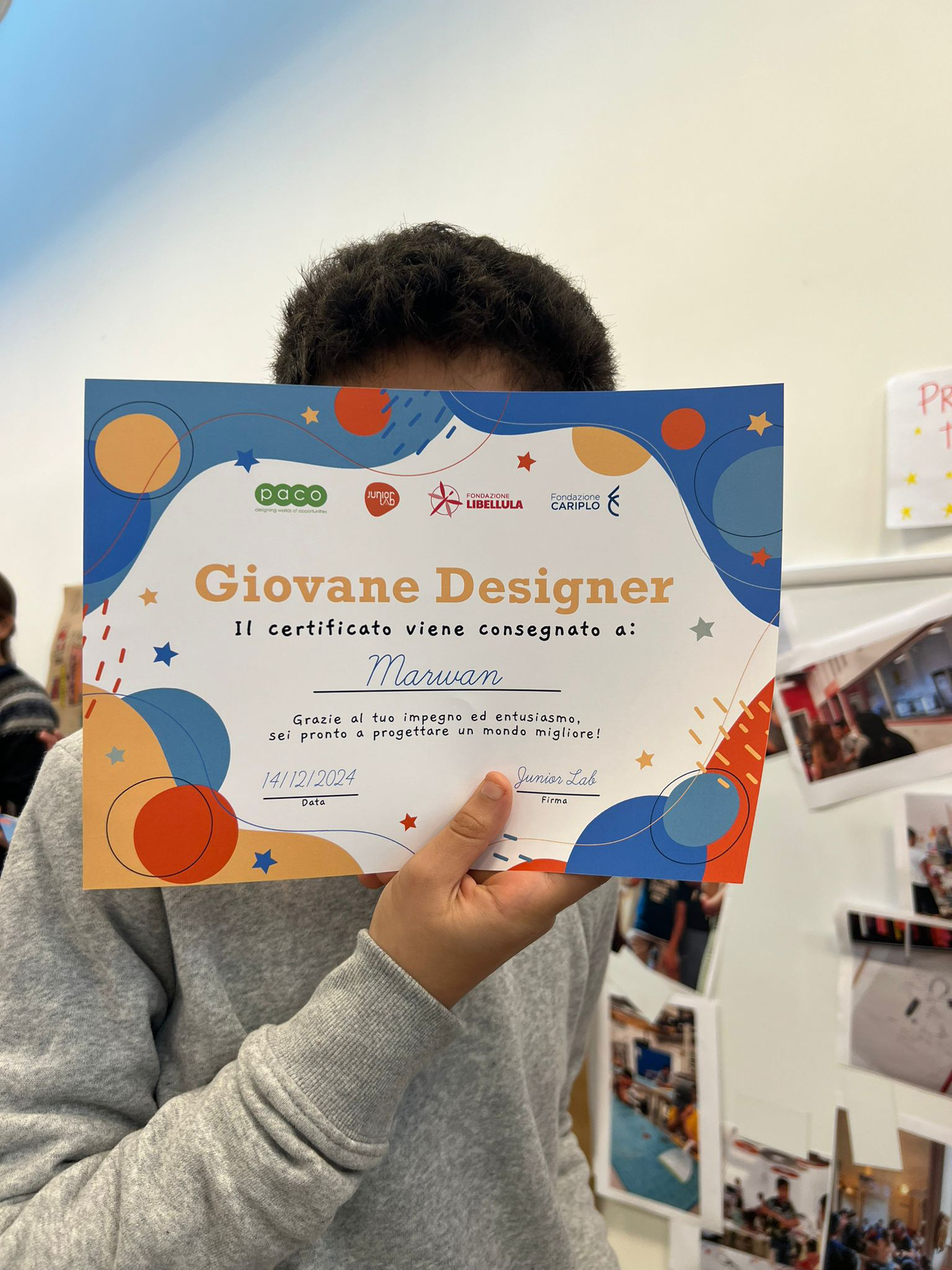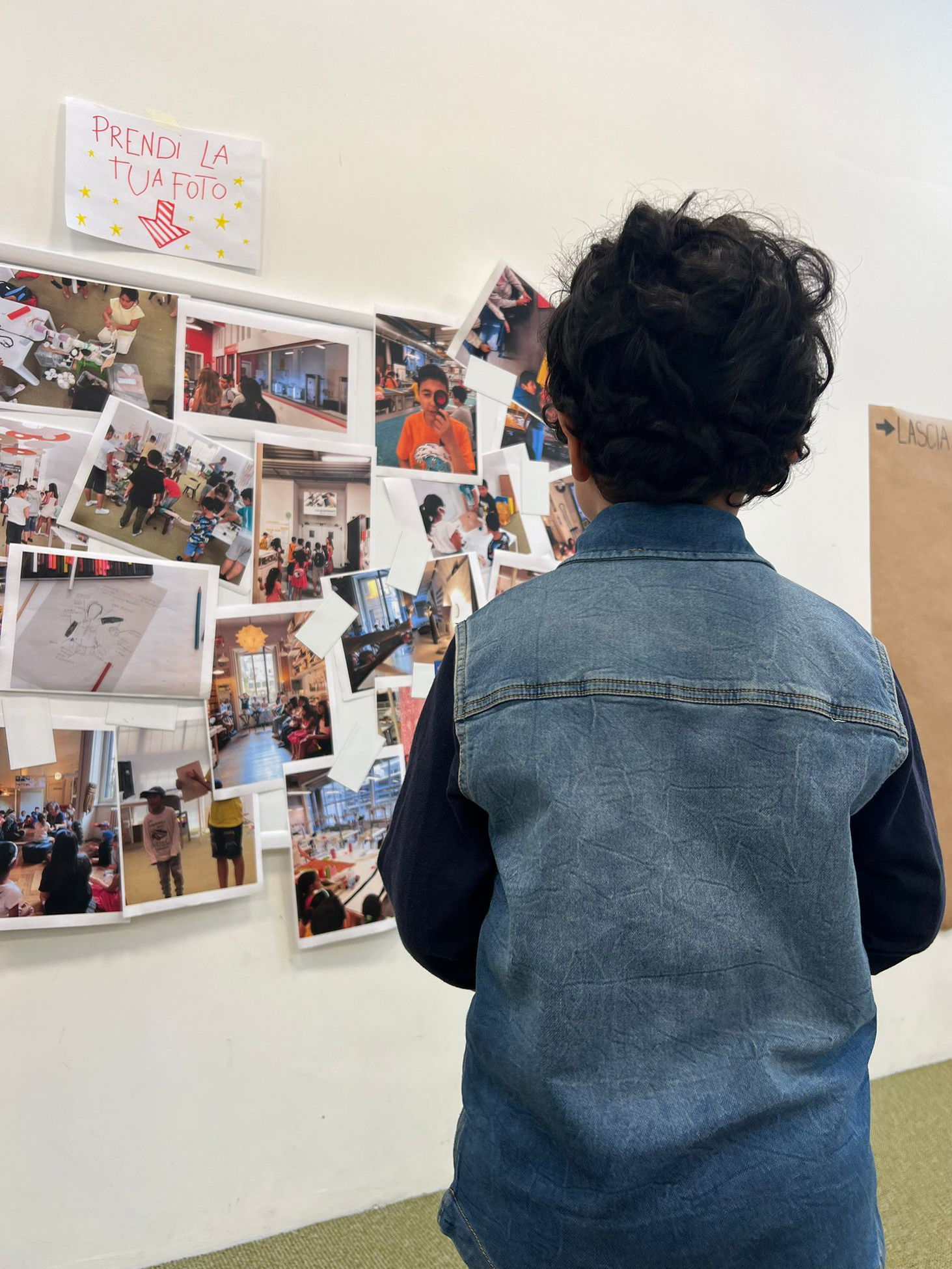Prioritising the places and people that need it the most
Young Designers of Milan
After school program at the museum - Young Designers of Milan
The project introduced children from socio-economically disadvantaged backgrounds to design, fostering creativity and critical thinking through museum visits and hands-on workshops. Aimed at children aged 6-12, the project offered immersive experiences in design, encouraging curiosity, exploration, and learning.
Italy
Local
Milan, Italy
Mainly urban
It refers to other types of transformations (soft investment)
Yes
2025-01-31
No
No
No
As a representative of an organisation, in partnership with other organisations
The "After school program at the museum - Young Designers of Milan" project introduced children from socio-economically disadvantaged backgrounds to design, fostering creativity and critical thinking through museum visits and hands-on workshops. Aimed at children aged 6-12, the project offered immersive experiences in design, encouraging curiosity, exploration, and learning. The program was structured into 8 modules across 14 meetings, covering various aspects of design. These included an introduction to design at ADI Design Museum, exploring the relationship between form and function at the Fondazione Vico Magistretti, and learning about materials at the Kartell Museum. The program also focused on sustainable design, with a visit to the Water Centre of Milano, and emphasized communicating ideas effectively through visits to institutions like Politecnico di Milano.
Through these activities, the project aimed to stimulate curiosity by exposing children to design history and artefacts, promoting critical thinking, and enhancing their knowledge of design principles, sustainability, and materials. The hands-on workshops helped develop practical design skills, enabling children to ideate, prototype, and communicate their ideas. Group activities fostered collaboration, teamwork, and communication skills, while the final event showcased the children's work. A brochure documented the outcomes, helping to disseminate the project’s impact.
In total, 60 children and 60 families participated, along with 11 partners, including 7 museums and 4 associations. The project increased the children's interest in design and concluded with a roundtable discussion on its methodology, replicability, and future opportunities. By making design education accessible to vulnerable children, the initiative empowered them to become creators and innovators in their communities.
Through these activities, the project aimed to stimulate curiosity by exposing children to design history and artefacts, promoting critical thinking, and enhancing their knowledge of design principles, sustainability, and materials. The hands-on workshops helped develop practical design skills, enabling children to ideate, prototype, and communicate their ideas. Group activities fostered collaboration, teamwork, and communication skills, while the final event showcased the children's work. A brochure documented the outcomes, helping to disseminate the project’s impact.
In total, 60 children and 60 families participated, along with 11 partners, including 7 museums and 4 associations. The project increased the children's interest in design and concluded with a roundtable discussion on its methodology, replicability, and future opportunities. By making design education accessible to vulnerable children, the initiative empowered them to become creators and innovators in their communities.
design
museum visits
hands-on workshops
marginalised children
after school program
The project placed sustainability at its core, aiming to teach children from vulnerable backgrounds how design can address environmental challenges. One key module, "Planet-centred design", focused on sustainable design, with a particular emphasis on water conservation.
In this module, children visited the water centre of Milano to learn about the water distribution system and the importance of preserving water. After the visit, they participated in a design workshop exploring water waste. They reflected on their daily water use and came up with creative ideas to reduce waste, turning a critical problem into an opportunity for improvement.
Children designed innovative systems to help save water at home and school. Their projects demonstrated how design can provide practical, eco-friendly solutions. By working on real-world issues like water conservation, the children developed a deeper understanding of sustainability and how design can contribute to a better future.
This module successfully met the project’s sustainability goals by encouraging children to think creatively about environmental issues and empowering them to take action through design. It showed how even small changes can have a big impact on the planet and how design education can inspire the next generation of eco-conscious thinkers.
In this module, children visited the water centre of Milano to learn about the water distribution system and the importance of preserving water. After the visit, they participated in a design workshop exploring water waste. They reflected on their daily water use and came up with creative ideas to reduce waste, turning a critical problem into an opportunity for improvement.
Children designed innovative systems to help save water at home and school. Their projects demonstrated how design can provide practical, eco-friendly solutions. By working on real-world issues like water conservation, the children developed a deeper understanding of sustainability and how design can contribute to a better future.
This module successfully met the project’s sustainability goals by encouraging children to think creatively about environmental issues and empowering them to take action through design. It showed how even small changes can have a big impact on the planet and how design education can inspire the next generation of eco-conscious thinkers.
The project aimed to provide a high-quality aesthetic and cultural experience for children from socio-economically disadvantaged backgrounds by immersing them in the world of design and creativity. The objective was to foster a deep appreciation for design and its impact on the world, enriching the children’s lives with experiences that highlighted both the beauty and functionality of design.
A key goal was to expose the children to the aesthetic value of design through visits to renowned museums and cultural institutions. Visits to the ADI Design Museum and the Kartell Museo allowed the children to explore design styles and movements, sparking their imagination and sensitivity toward the connection between form, function, and beauty. These venues created an inspiring environment where children could engage with iconic design objects, making design more tangible and exciting. This exposure helped children see design not only as functional but also as an expression of culture and values.
Workshops also aimed to enhance the quality of the children’s creative experience by offering hands-on opportunities to explore design processes. They were encouraged to think critically about aesthetics, considering factors such as colour, material, texture, and usability. Prototyping and model-building activities helped the children understand how design decisions affect both the appearance and functionality of objects while promoting sustainability by introducing eco-friendly design practices.
A key goal was to expose the children to the aesthetic value of design through visits to renowned museums and cultural institutions. Visits to the ADI Design Museum and the Kartell Museo allowed the children to explore design styles and movements, sparking their imagination and sensitivity toward the connection between form, function, and beauty. These venues created an inspiring environment where children could engage with iconic design objects, making design more tangible and exciting. This exposure helped children see design not only as functional but also as an expression of culture and values.
Workshops also aimed to enhance the quality of the children’s creative experience by offering hands-on opportunities to explore design processes. They were encouraged to think critically about aesthetics, considering factors such as colour, material, texture, and usability. Prototyping and model-building activities helped the children understand how design decisions affect both the appearance and functionality of objects while promoting sustainability by introducing eco-friendly design practices.
The project aimed to provide children from socio-economically disadvantaged backgrounds with an opportunity to acquire design skills, equipping them with new tools to interpret reality and imagine the future. By addressing the intersection of economic poverty and cultural deprivation, the project sought to break down barriers to access, offering a pathway into cultural spaces and creative learning that might otherwise be inaccessible.
Inclusion was a central focus of the project, ensuring both accessibility and affordability. All activities, from museum visits to hands-on workshops, were provided free of charge, removing the financial barrier that often limits access to cultural and educational opportunities. By partnering with local museums, cultural institutions, and foundations, the project created new points of contact between children in vulnerable situations and the cultural assets of their community. This was particularly important in a post-pandemic context, where access to cultural experiences was even more fragmented, especially for marginalized groups.
Furthermore, the project promoted new societal models by emphasizing the role of design as a tool for empowerment and social change. It not only gave children the chance to engage with the world of design but also helped them develop a sense of agency in addressing social and environmental issues. Through collaborative work, the children developed both practical design skills and an understanding of how design can shape a better future.
In this context, the project serves as an exemplary model of how design education can be inclusive, providing children from all backgrounds with the opportunity to engage with culture, creativity, and problem-solving, ultimately fostering a more inclusive society.
Inclusion was a central focus of the project, ensuring both accessibility and affordability. All activities, from museum visits to hands-on workshops, were provided free of charge, removing the financial barrier that often limits access to cultural and educational opportunities. By partnering with local museums, cultural institutions, and foundations, the project created new points of contact between children in vulnerable situations and the cultural assets of their community. This was particularly important in a post-pandemic context, where access to cultural experiences was even more fragmented, especially for marginalized groups.
Furthermore, the project promoted new societal models by emphasizing the role of design as a tool for empowerment and social change. It not only gave children the chance to engage with the world of design but also helped them develop a sense of agency in addressing social and environmental issues. Through collaborative work, the children developed both practical design skills and an understanding of how design can shape a better future.
In this context, the project serves as an exemplary model of how design education can be inclusive, providing children from all backgrounds with the opportunity to engage with culture, creativity, and problem-solving, ultimately fostering a more inclusive society.
Citizens, particularly children from socio-economically disadvantaged backgrounds, were central to the project’s design and impact. The children were actively involved in all stages, from engaging in museum visits to participating in hands-on workshops, allowing them to directly influence the creative process. Their role was to explore, question, and co-create design solutions, fostering a sense of ownership and agency.
Families were also engaged, especially during the final events where children showcased their work. This created a sense of community involvement and reinforced the importance of design education. Civil society was engaged through partnerships with local museums, foundations, and cultural institutions, which provided resources and expertise. Their involvement strengthened the project’s reach and ensured a lasting impact, facilitating greater access to cultural experiences for marginalized groups and contributing to broader societal change.
Families were also engaged, especially during the final events where children showcased their work. This created a sense of community involvement and reinforced the importance of design education. Civil society was engaged through partnerships with local museums, foundations, and cultural institutions, which provided resources and expertise. Their involvement strengthened the project’s reach and ensured a lasting impact, facilitating greater access to cultural experiences for marginalized groups and contributing to broader societal change.
Stakeholders at the local level played a crucial role in the design and implementation of the project. Museums, cultural institutions, and foundations provided resources, expertise, and access to their spaces, enabling hands-on experiences for children. Their involvement was vital for ensuring that the activities were engaging and contextually relevant.
Educational organizations supported the project by facilitating connections with community groups, ensuring inclusivity and reaching children from socio-economically disadvantaged backgrounds. The project was co-financed by Fondazione Cariplo, whose support significantly strengthened its sustainability and reach.
Educational organizations supported the project by facilitating connections with community groups, ensuring inclusivity and reaching children from socio-economically disadvantaged backgrounds. The project was co-financed by Fondazione Cariplo, whose support significantly strengthened its sustainability and reach.
The project integrated multiple disciplines to offer a well-rounded learning experience for children, focusing on design, education, and cultural heritage.
Design was central to the project, guiding both the pedagogical approach and the hands-on activities. Design experts facilitated workshops, teaching children how to approach problems creatively, explore design thinking, and develop prototyping skills. Their expertise shaped the project’s content, providing valuable insights into how to make the design process accessible and engaging for young minds.
Education was another key discipline that influenced the teaching methods used throughout the project. Educators with experience in creative learning and experiential education developed and implemented the curriculum, ensuring that activities were pedagogically sound and appropriate for the children’s age group. They also helped adapt the content to meet the needs of children from socio-economically disadvantaged backgrounds, making sure it was both inclusive and accessible.
Cultural heritage was reflected through museum visits, where curators and museum educators connected design history with modern practices. This provided children with a deep appreciation for design as part of cultural evolution.
The collaboration between these fields created an interdisciplinary approach that enhanced the project’s impact. Design experts worked with educators to develop practical activities, while cultural professionals helped contextualize the lessons in the real world. This approach not only taught children design skills but also encouraged them to think critically about design’s societal and environmental implications.
Design was central to the project, guiding both the pedagogical approach and the hands-on activities. Design experts facilitated workshops, teaching children how to approach problems creatively, explore design thinking, and develop prototyping skills. Their expertise shaped the project’s content, providing valuable insights into how to make the design process accessible and engaging for young minds.
Education was another key discipline that influenced the teaching methods used throughout the project. Educators with experience in creative learning and experiential education developed and implemented the curriculum, ensuring that activities were pedagogically sound and appropriate for the children’s age group. They also helped adapt the content to meet the needs of children from socio-economically disadvantaged backgrounds, making sure it was both inclusive and accessible.
Cultural heritage was reflected through museum visits, where curators and museum educators connected design history with modern practices. This provided children with a deep appreciation for design as part of cultural evolution.
The collaboration between these fields created an interdisciplinary approach that enhanced the project’s impact. Design experts worked with educators to develop practical activities, while cultural professionals helped contextualize the lessons in the real world. This approach not only taught children design skills but also encouraged them to think critically about design’s societal and environmental implications.
The project is innovative in its integration of design education, cultural engagement, and social inclusion. Unlike traditional models, it offers vulnerable children, often excluded from cultural experiences, the opportunity to explore design through hands-on workshops and museum visits. This immersive approach allows children to not only learn about design but also actively engage in creating prototypes, fostering creativity and critical thinking.
A key innovation is the focus on sustainability, particularly through modules like water conservation, where children are introduced to eco-conscious design practices. This empowers them to see design as a tool for addressing global challenges.
The project also stands out by bringing together professionals from various fields—design, education, and cultural heritage—in a collaborative environment. This multidisciplinary approach enhances the learning experience, offering children a comprehensive view of design's role in society. By combining education with real-world application, the project goes beyond traditional methods, encouraging children to think critically and creatively about their world and their future.
A key innovation is the focus on sustainability, particularly through modules like water conservation, where children are introduced to eco-conscious design practices. This empowers them to see design as a tool for addressing global challenges.
The project also stands out by bringing together professionals from various fields—design, education, and cultural heritage—in a collaborative environment. This multidisciplinary approach enhances the learning experience, offering children a comprehensive view of design's role in society. By combining education with real-world application, the project goes beyond traditional methods, encouraging children to think critically and creatively about their world and their future.
The project employed a participatory, experiential methodology, focusing on hands-on learning and cultural immersion. The project combined design thinking principles with active engagement in real-world contexts, allowing children to learn through doing. Children were exposed to design through museum visits, where they explored iconic works, and followed by workshops at the Junior Design Lab, where they put their ideas into practice.
The methodology was structured around eight modules, each focused on different aspects of design, from material exploration to sustainability. For instance, the "Planet centred design" module, which addressed environmental sustainability, included a visit to the Water Centre of Milano and a workshop where children explored water conservation through creative prototyping. These activities were designed to stimulate critical thinking, encourage problem-solving, and build design skills.
A key feature of the approach was the collaborative learning environment. Children worked in groups, fostering teamwork, communication, and peer learning. Educators, designers, and cultural professionals were actively involved, creating an interdisciplinary atmosphere that integrated art, design, and sustainability. This holistic approach enabled children to not only develop practical design skills but also deepen their understanding of cultural heritage and environmental responsibility.
The methodology was structured around eight modules, each focused on different aspects of design, from material exploration to sustainability. For instance, the "Planet centred design" module, which addressed environmental sustainability, included a visit to the Water Centre of Milano and a workshop where children explored water conservation through creative prototyping. These activities were designed to stimulate critical thinking, encourage problem-solving, and build design skills.
A key feature of the approach was the collaborative learning environment. Children worked in groups, fostering teamwork, communication, and peer learning. Educators, designers, and cultural professionals were actively involved, creating an interdisciplinary atmosphere that integrated art, design, and sustainability. This holistic approach enabled children to not only develop practical design skills but also deepen their understanding of cultural heritage and environmental responsibility.
The project has several elements that can be replicated or transferred to other places and contexts.
First of all the methodology. The core of the project’s approach is a blend of participatory learning, museum visits, and hands-on workshops, all underpinned by design thinking principles. This methodology can be easily adapted to other locations, as it requires minimal resources other than access to museums or cultural spaces and facilitators to run workshops. The structured, yet flexible format—incorporating multiple learning modules, each with clear educational goals—makes the project adaptable to diverse groups, ages, or educational contexts.
Another aspects is the collaboration with local cultural institutions. Partnering with local museums, foundations, and design institutions was key to the project’s success. This model of collaboration can be replicated in other cities or regions, where local cultural institutions collaborate with schools or community organizations. This would ensure that children have access to cultural education, even in socio-economically disadvantaged areas.
These elements make the project transferable, with the potential for positive impact in various contexts.
First of all the methodology. The core of the project’s approach is a blend of participatory learning, museum visits, and hands-on workshops, all underpinned by design thinking principles. This methodology can be easily adapted to other locations, as it requires minimal resources other than access to museums or cultural spaces and facilitators to run workshops. The structured, yet flexible format—incorporating multiple learning modules, each with clear educational goals—makes the project adaptable to diverse groups, ages, or educational contexts.
Another aspects is the collaboration with local cultural institutions. Partnering with local museums, foundations, and design institutions was key to the project’s success. This model of collaboration can be replicated in other cities or regions, where local cultural institutions collaborate with schools or community organizations. This would ensure that children have access to cultural education, even in socio-economically disadvantaged areas.
These elements make the project transferable, with the potential for positive impact in various contexts.
The project addresses global challenges with local solutions through design education, creativity, and community engagement.
1. Social inequality and access to education. By targeting socio-economically disadvantaged children, the project offers opportunities typically out of reach, addressing social inequality. It provides access to design education and cultural spaces, leveling the playing field for children excluded from these opportunities.
2. Cultural exclusion. The project bridges the gap between marginalized communities and cultural institutions, ensuring children from disadvantaged backgrounds can engage with creative education and cultural heritage, promoting long-term cultural inclusion.
3. Sustainability. The project tackles climate change by teaching children about environmental responsibility, such as water conservation.
4. Lack of design education. Offering design thinking and creativity to vulnerable communities, the project equips children with skills to address global issues demonstrating the importance of creativity and problem-solving in a changing world.
5. Social and emotional development. The project promotes mental well-being by encouraging teamwork, collaboration, and self-expression, helping children develop resilience and social skills, which are crucial in post-pandemic society.
1. Social inequality and access to education. By targeting socio-economically disadvantaged children, the project offers opportunities typically out of reach, addressing social inequality. It provides access to design education and cultural spaces, leveling the playing field for children excluded from these opportunities.
2. Cultural exclusion. The project bridges the gap between marginalized communities and cultural institutions, ensuring children from disadvantaged backgrounds can engage with creative education and cultural heritage, promoting long-term cultural inclusion.
3. Sustainability. The project tackles climate change by teaching children about environmental responsibility, such as water conservation.
4. Lack of design education. Offering design thinking and creativity to vulnerable communities, the project equips children with skills to address global issues demonstrating the importance of creativity and problem-solving in a changing world.
5. Social and emotional development. The project promotes mental well-being by encouraging teamwork, collaboration, and self-expression, helping children develop resilience and social skills, which are crucial in post-pandemic society.
The project achieved significant results, impacting both direct and indirect beneficiaries. Over 60 children, mainly from socio-economically disadvantaged backgrounds, were introduced to design through museum visits and hands-on workshops. These activities fostered creativity, critical thinking, and problem-solving skills while encouraging teamwork and collaboration.
Children developed a deeper understanding of design principles, sustainability, and innovation, with many expressing an increased interest in design as a career. The project also bridged the gap between vulnerable children and cultural institutions, offering them exposure to spaces they may not have had access to before.
The final event, which showcased the children’s work, helped strengthen community ties and promote cultural exchange. It also raised awareness of the importance of design education for children in vulnerable contexts. The collaboration with 11 partners, including museums and foundations, ensured broad reach and valuable exchanges, helping to build long-term support for design education.
Overall, the project empowered children, enriched their cultural experiences, and had a lasting impact on both their personal growth and their communities, inspiring a new generation of creative thinkers.
Children developed a deeper understanding of design principles, sustainability, and innovation, with many expressing an increased interest in design as a career. The project also bridged the gap between vulnerable children and cultural institutions, offering them exposure to spaces they may not have had access to before.
The final event, which showcased the children’s work, helped strengthen community ties and promote cultural exchange. It also raised awareness of the importance of design education for children in vulnerable contexts. The collaboration with 11 partners, including museums and foundations, ensured broad reach and valuable exchanges, helping to build long-term support for design education.
Overall, the project empowered children, enriched their cultural experiences, and had a lasting impact on both their personal growth and their communities, inspiring a new generation of creative thinkers.

